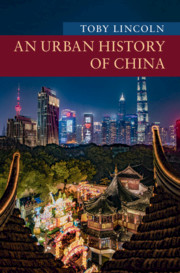Book contents
- An Urban History of China
- New Approaches to Asian History
- An Urban History of China
- Copyright page
- Contents
- Figures
- Maps
- Tables
- Acknowledgements
- Introduction
- 1 The Emergence of China’s Imperial Urban Civilization (Antiquity to 220 CE)
- 2 The Expansion of China’s Imperial Urban Civilization to the South (220–755)
- 3 The Tang-Song Transition and Its Effects on China’s Imperial Urban Civilization (907–1402)
- 4 The Flowering of Chinese Imperial Urban Civilization (1402–1799)
- 5 The Seeds of Urban Modernity (1800–1895)
- 6 Urban Modernity in Republican China (1895–1949)
- 7 The Maoist Period (1949–1976)
- 8 The Reform Era and the Present
- Conclusion
- Index
- Series page
- References
8 - The Reform Era and the Present
Published online by Cambridge University Press: 29 April 2021
- An Urban History of China
- New Approaches to Asian History
- An Urban History of China
- Copyright page
- Contents
- Figures
- Maps
- Tables
- Acknowledgements
- Introduction
- 1 The Emergence of China’s Imperial Urban Civilization (Antiquity to 220 CE)
- 2 The Expansion of China’s Imperial Urban Civilization to the South (220–755)
- 3 The Tang-Song Transition and Its Effects on China’s Imperial Urban Civilization (907–1402)
- 4 The Flowering of Chinese Imperial Urban Civilization (1402–1799)
- 5 The Seeds of Urban Modernity (1800–1895)
- 6 Urban Modernity in Republican China (1895–1949)
- 7 The Maoist Period (1949–1976)
- 8 The Reform Era and the Present
- Conclusion
- Index
- Series page
- References
Summary
During the Reform Era, China finally became an urban society. Foreign investment funded factories in coastal cities, which grew rapidly, many new inhabitants migrant labourers from west China. Large cities such as Chongqing, Guangzhou, and Shanghai are the centres of megacity regions. These are agglomerations of cities criss-crossed with transport networks and connected to the rest of China by high-speed rail and air. Municipal officials seeking ever higher levels of economic growth have presided over urban expansion. At their best, Chinese cities are innovative, hosting the work of internationally reknowned architects, and incorporating ideas of eco-cities or livable cities. At their worst, they are poorly planned urban sprawl, where the natural environment has been ruined, historical buildings demolished, and communities destroyed. The state has withdrawn from the direct micromanagement of urban life and been replaced by overlapping informal community organizations, but surveillance technologies now give the government more control. Meanwhile, a new entrepreneurial and professional middle class enjoys a new sense of urban sophistication based on property and vehicle ownership, education, consumption of international brands, and foreign travel. However, millions of migrant workers live a precarious urban existence, often far away from their families in the countryside.
- Type
- Chapter
- Information
- An Urban History of China , pp. 223 - 253Publisher: Cambridge University PressPrint publication year: 2021



